



Table of Contents
- Property Tax in India 2025
- What is Property Tax used for?
- What are the Types of Property?
- Factors for Calculating Property Tax
- Ways to Calculate Property Tax
- Formula for Calculating Property Tax
- Property Tax in Pune
- Property Tax in Bengaluru
- Property Tax in Mumbai
- Property Tax in Gurugram
- Property Tax in Delhi
- Property Tax in Hyderabad
- Property Tax in Chennai
- Property Tax in Kolkata
- Property Tax in Ahmedabad
- Property Tax in Chandigarh
- Property Tax in Nagpur
- Property Tax in Noida
- Property Tax in Kochi
- Understanding House Property Income Taxation
- What is a Tax Application Number?
- How to download Property Tax Receipts?
- Why is Paying Property Tax Important?
- Penalties for Non Payment
- Conclusion
- Faq's
Property Tax in India 2025
The Union Budget 2025 has introduced significant changes in property taxation in India, aiming to provide relief to homeowners and streamline tax compliance. One of the most notable updates is the exemption on self-occupied properties, which now allows individuals to own up to two self-occupied properties without incurring tax on notional rental income. Previously, homeowners were taxed on their second property's estimated rental value, even if it was not rented out. This reform is expected to encourage homeownership and make it easier for individuals to invest in multiple properties without additional tax burdens.
Additionally, the Long-Term Capital Gains (LTCG) tax structure has been revised, with the Finance (No. 2) Act, 2024, setting a standard LTCG tax rate of 12.5 percent for all taxpayers. This amendment, effective from April 1, 2025, replaces the previous system where sellers had to choose between a 20 percent tax with indexation or a flat tax rate. The new structure ensures parity among taxpayers and is expected to increase liquidity in the real estate market, making it easier for investors to sell properties without significant tax liabilities.
Furthermore, municipal property tax regulations continue to evolve across various states, with several local governments implementing digital tax payment systems to enhance transparency and efficiency. Homeowners can calculate their property tax liabilities based on location, usage, property size, and municipal valuation methods such as the Unit Area Value, Capital Value System, and Annual Rental Value methods. These changes collectively aim to simplify the tax system, reduce tax burdens, and encourage investment in the Indian real estate market, benefiting both homeowners and investors in 2025.
What is Property Tax used for?
Property tax in India serves multiple crucial purposes, acting as a cornerstone of revenue for local municipal bodies and playing a pivotal role in shaping urban development and community well-being.
1. Local Government Revenue:
Property tax stands as a primary revenue source for local municipal bodies and urban local bodies. These funds are essential for sustaining the day-to-day operations of local governance and providing necessary services to residents.
2. Infrastructure Development:
Revenue generated from property taxes is instrumental in funding infrastructure projects such as road construction, drainage systems, parks, and other public amenities. This investment is vital for enhancing the overall quality of life in urban and rural areas alike.
3. Public Services and Utilities:
Property tax funds are allocated towards providing essential public services and utilities including water supply, sanitation facilities, street lighting, waste management, and public transportation. These services contribute significantly to the health, safety, and convenience of residents.
4. Urban Planning and Development:
Property tax revenues play a crucial role in financing urban planning initiatives and development projects. This includes land use regulations, zoning, and the implementation of sustainable development practices to ensure the efficient use of land and resources.
5. Maintenance of Common Areas:
Property tax revenue is utilized for the maintenance and upkeep of common areas such as public parks, playgrounds, community centers, and recreational facilities. Well-maintained common spaces promote community engagement and enhance the overall livability of neighborhoods.
6. Municipal Governance and Autonomy:
Property tax revenue provides local municipal bodies with financial autonomy, allowing them to govern effectively and address the specific needs and priorities of their communities. This fosters local accountability and responsiveness to citizen demands.
7. Equitable Taxation:
Property tax is based on the principle of wealth and property ownership, ensuring that individuals contribute to local government funds based on the value and type of property they own. This progressive taxation approach helps in achieving a more equitable distribution of the tax burden.
8. Encouraging Proper Land Use:
Property tax policies can be structured to incentivize proper land use and discourage the hoarding of vacant or underutilized land. This encourages property owners to develop or utilize their land efficiently, contributing to urban sustainability and economic growth.
9. Support for Local Services:
Property tax revenues are often earmarked for specific purposes such as education, healthcare, and social welfare programs within the local jurisdiction. This targeted allocation ensures that tax funds directly benefit the community by improving vital services and amenities.
Overall, property tax serves as a vital tool for financing local governance, fostering sustainable development, and enhancing the overall quality of life for residents across urban and rural areas in India.
What are the Types of Property?
|
Property Type |
Description |
|
Personal Property |
Man-made objects that can be moved, such as cars, buses, trucks, cranes, and similar items. |
|
Land |
Core land without any construction or improvement done to it. |
|
Improvements to Land |
Construction or improvements made to land, such as buildings or warehouses. |
|
Intangible Property |
Ownership of properties without physical substance, including patents, copyrights, and royalties. |
Factors for Calculating Property Tax
Calculating property tax involves a comprehensive assessment that takes into account various factors, ensuring a fair and accurate estimation of tax liabilities. While specific methods may vary among civic agencies, the underlying principles and factors considered are generally consistent across jurisdictions.
Here's an overview of how property tax calculations are typically conducted, considering factors such as location, occupancy status, property type, amenities, construction details, and more:
1. Location:
The geographical location of a property plays a significant role in its valuation for tax purposes. Properties in prime locations, with better access to amenities, infrastructure, and services, may have higher assessed values compared to those in less desirable areas.
2. Occupancy Status:
The occupancy status of the property is a crucial factor. Properties can be categorized as self-occupied, rented out, vacant, or under construction. Different occupancy statuses may have varying tax implications, such as owner-occupied properties often receiving certain exemptions or deductions.
3. Property Type:
Properties are classified into different categories such as residential, commercial, industrial, agricultural, or vacant land. Each category may have specific tax rates, exemptions, or assessment criteria based on its intended use and zoning regulations.
4. Amenities Provided:
Amenities such as car parking facilities, rainwater harvesting systems, solar panels, or other sustainable features can influence property tax assessments. Properties with additional amenities or green initiatives may qualify for tax incentives or rebates in some jurisdictions.
5. Year of Construction:
The age of a property is considered in tax assessments, reflecting factors such as depreciation, maintenance costs, and overall property condition. Older properties may be subject to different tax rates or depreciation allowances compared to newer constructions.
6. Type of Construction:
The construction type, whether it's a single-floor structure, multi-storied building, or traditional (pukka) versus temporary (kutcha) construction, is assessed for its durability, safety standards, and overall quality, impacting the property's assessed value.
7. Floor Space Index (FSI):
In urban areas, FSI or Floor Area Ratio (FAR) is a key parameter used to regulate building density and permissible construction. Properties with higher FSI values may have higher assessed values and subsequently, higher property tax obligations.
8. Carpeted Square Area:
The actual usable or carpeted area of the property is measured and considered in tax assessments. This excludes common areas, balconies, and utility spaces, focusing on the space that occupants directly use for living or business purposes.
Civic agencies utilize these factors along with applicable tax rates, formulas, and assessment guidelines to calculate property taxes. The goal is to ensure fairness, transparency, and consistency in tax assessments while also considering the specific characteristics and circumstances of each property. Property owners should review assessment notices, understand the assessment criteria, and seek clarification or appeal if they believe there are discrepancies or inaccuracies in their property tax assessments.
Ways to Calculate Property Tax
Let's delve deeper into each method of property tax calculation used by municipal authorities in India:
1. Unit Area Value System:
- This method calculates property taxes based on the per-unit price of the property's built-up area.
- The price per unit is determined considering factors such as the property's expected returns, its usage (residential, commercial, industrial), location (prime areas, suburbs), and prevailing land prices in the locality.
- Municipal authorities assess a specific value per square foot or square meter of built-up area, which serves as the basis for tax calculation.
- Cities like Delhi, Hyderabad, Bengaluru, Patna, and Kolkata employ the Unit Area Value System for property tax assessment.
- This system aims to reflect the property's value about its physical dimensions and potential income generation, ensuring a fair tax assessment.
2. Capital Value System (CVS):
- Under the CVS, property tax is determined as a percentage of the market value of the property.
- The government or municipal authorities establish the market value based on various factors including the property's location, amenities, demand-supply dynamics, and overall real estate market trends.
- This valuation system is commonly used in Mumbai and other regions where property values are dynamic and subject to frequent market fluctuations.
- The property's market value serves as a key determinant in calculating the annual property tax, with higher-valued properties generally attracting higher tax liabilities.
- The CVS aims to align property tax assessments with prevailing market conditions and property valuations, ensuring that tax obligations reflect the property's worth.
3. Annual Rented Value System:
- In this system, property tax calculation is based on the annual rental value of a property.
- The rental value is assessed considering factors such as the property's location, size, condition, proximity to amenities and landmarks, and prevailing rental rates in the area.
- Municipal authorities determine a standardized formula or rate to calculate the tax based on a percentage of the property's annual rental value.
- Cities like Chennai and certain parts of Hyderabad utilize the Annual Rented Value System to ascertain property tax amounts.
- This method aims to reflect the income potential and market value of the property through its rental value, providing a basis for fair and proportional tax assessments.
These methods demonstrate the diverse approaches used by municipal authorities to calculate property taxes, each tailored to capture different aspects of property value and usage. By employing these systems, authorities aim to ensure equitable taxation while also generating essential revenue for local governance and infrastructure development.
|
Property Tax Calculation Method |
Description |
Cities/Regions Using This Method |
|
Unit Area Value System |
Taxes are calculated based on the per-unit price of a property's built-up area. Factors such as expected returns, property usage, location, and land prices are considered to determine the unit price. The built-up area is then multiplied by the unit price to arrive at the property tax valuation. |
Delhi, Hyderabad, Bengaluru, Patna, Kolkata |
|
Capital Value System (CVS) |
Property tax is derived as a percentage of the market value of the property. The market value is determined based on factors like property location, amenities, demand-supply dynamics, and prevailing market conditions. This valuation system is particularly used in areas with dynamic property values such as Mumbai. |
Mumbai |
|
Annual Rented Value System |
Tax calculation is based on the annual rental value of the property. Factors such as location, size, condition, proximity to amenities, and prevailing rental rates influence the rental value assessment. Municipalities establish a formula or rate to calculate tax based on a percentage of the property's annual rental value. |
Chennai, certain parts of Hyderabad |
Formula for Calculating Property Tax
Property tax = Base value × Built-up area × Age factor × Type of building × Category of use × Floor factor
This formula takes into account various factors such as the property's base value, built-up area, age factor, type of building, category of use, and floor factor to determine the property tax amount.
Property Tax in Pune
PMC Website:
http://propertytax.punecorporation.org/
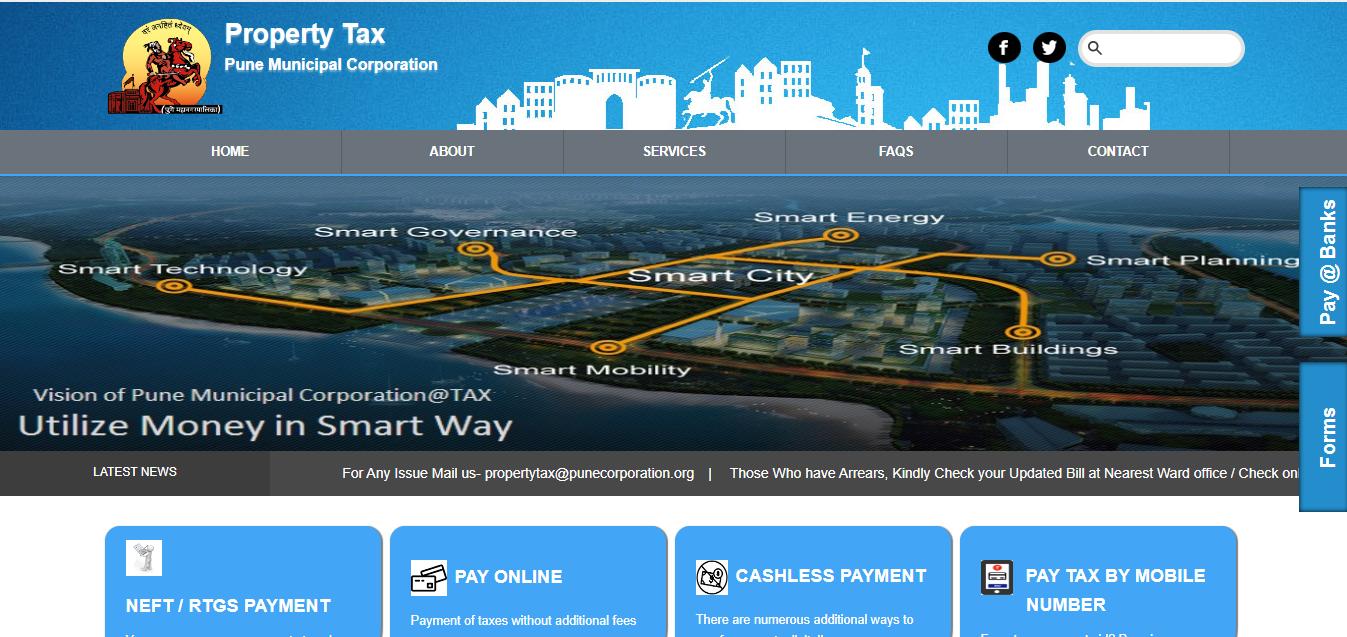 Pune Municipal Corporation Website
Pune Municipal Corporation Website
The Pune Municipal Corporation (PMC) provides an efficient online property tax calculator to help property owners determine their tax liabilities accurately. By inputting specific details into the calculator, individuals can assess the amount of property tax owed to the PMC. Here's a detailed overview of the factors you need to consider when using the PMC's property tax calculator:
1. Location: The location of your property plays a crucial role in determining the tax rate. Different areas within Pune may have varying tax rates based on the locality's infrastructure, amenities, and development status.
2. Area: The total area of your property, including both land and built-up area, influences the property tax calculation. Larger properties generally incur higher tax amounts due to their size and potential usage.
3. Usage: The intended use of your property also impacts tax calculations. Residential, commercial, industrial, and mixed-use properties may have different tax rates based on their designated usage category.
4. Type: Property types such as apartments, independent houses, commercial complexes, and vacant land may have distinct tax considerations. Each type is assessed differently based on its characteristics and usage patterns.
5. Total Plinth Area: The total plinth area, which includes the built-up area of the property, is a key parameter in property tax assessment. It reflects the size and construction details of the property, influencing tax calculations.
6. Construction Year: The year in which the property was constructed or renovated is essential for determining depreciation and age-related factors in tax calculations. Older properties may have different tax rates compared to newer constructions.
Using these details in the PMC's online property tax calculator, property owners can obtain an accurate estimation of their tax obligations. It's important to ensure that the information provided is up-to-date and accurate to avoid discrepancies in tax assessments. The online calculator simplifies the tax calculation process and promotes transparency in property tax management within Pune.
Also Read: How to Pay Property Tax in Pune 2024
Property Tax in Bengaluru
BBMP Website:
https://bbmptax.karnataka.gov.in/
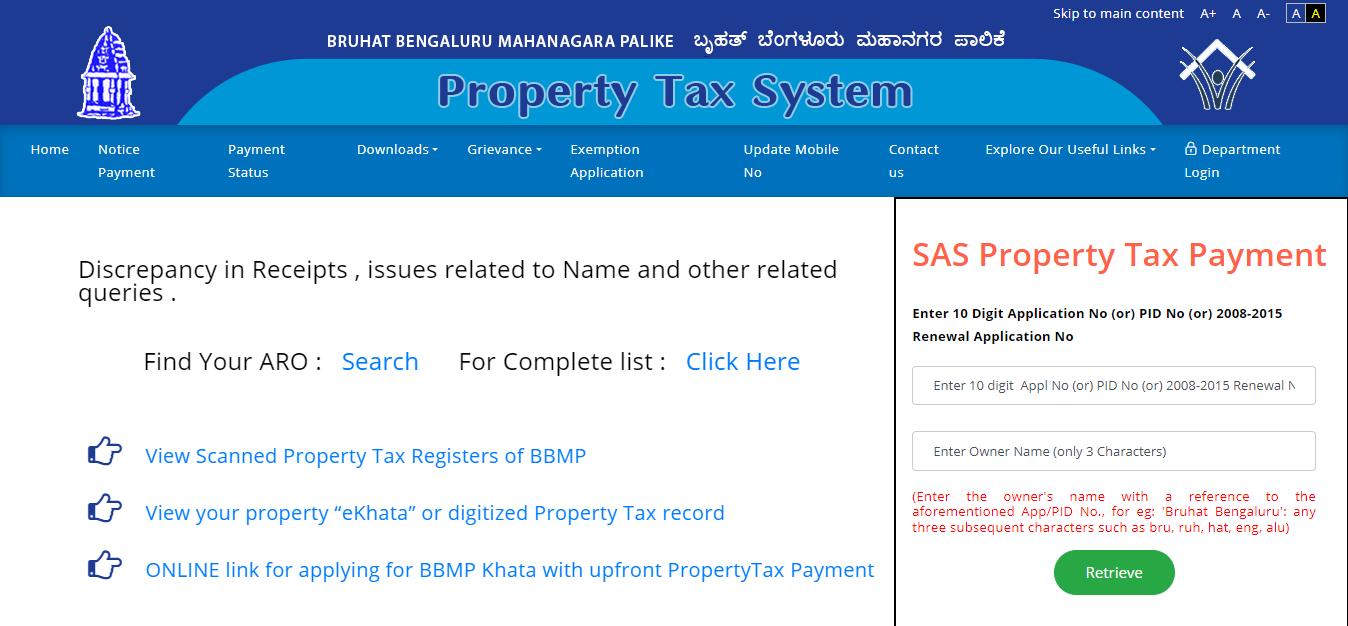 Bruhat Bengaluru Mahanagara Palike Website
Bruhat Bengaluru Mahanagara Palike Website
The Bruhat Bengaluru Mahanagara Palike (BBMP) employs a Unit Area Value (UAV) system to calculate property tax, ensuring a fair and transparent assessment of tax liabilities for property owners in Bengaluru. Let's delve into the details of how property tax is computed under this system:
Formula for Property Tax Calculation in Bengaluru (UAV System)
The property tax calculation formula used by BBMP is as follows:
Property Tax (K)=(G-I)×20%
Here are the components of the formula:
- G represents the Gross Unit Area Value, which is calculated as the sum of X+Y+Z.
- X denotes the tenanted area of the property multiplied by the per square foot rate of the property and then further multiplied by 10 months.
- Y represents the self-occupied area of the property multiplied by the per square foot rate of the property and then further multiplied by 10 months.
- Z stands for the vehicle parking area, which is multiplied by the per square foot rate of the parking area and then further multiplied by 10 months.
- I represents the depreciation value, calculated as Gx H/100 where H is the percentage of depreciation rate based on the age of the property.
Factors Influencing Property Tax Calculation
- Tenanted Area: The area of the property that is rented out affects the tax calculation based on the prevailing rates.
- Self-Occupied Area: The portion of the property that you reside in is considered differently in tax assessment.
- Vehicle Parking Area: Any designated parking area associated with the property is also factored into the tax calculation.
- Depreciation Rate: The age of the property influences the depreciation rate H, which in turn impacts the overall tax liability.
Importance of Property Tax Calculation
- Revenue Generation: Property tax serves as a significant source of revenue for BBMP, contributing to the development and maintenance of civic amenities in Bengaluru.
- Fair Assessment: The UAV system ensures a fair and transparent assessment of property tax, aligning with the property's characteristics and usage.
Property Tax in Mumbai
The Brihanmumbai Municipal Corporation (BMC) implements the Capital Value System (CVS) for property tax assessment in Mumbai. Let's explore how property tax is calculated under this system and understand recent developments and online payment options related to property tax in Mumbai.
Property Tax Calculation under Capital Value System (CVS)
The BMC calculates property tax using the following formula:
Property Tax= Capital Value of Property×Current Property Tax Rate(%)×Weight for User Category
- Capital Value of Property: This refers to the assessed value of the property based on its market worth and other valuation factors.
- Current Property Tax Rate (%): The tax rate applied to the capital value, which may vary based on different factors such as property type, usage, and location.
- Weight for User Category: This factor accounts for different user categories (residential, commercial, industrial) and may adjust tax rates accordingly.
Exemption for Residential Properties
The Maharashtra cabinet's approval of exempting residential properties up to 500 sq ft from property tax within Mumbai municipal limits aims to provide relief to smaller property owners. This exemption aligns with efforts to support affordable housing and ease financial burdens on certain property segments.
Also Read: How to Pay MCGM Property Tax in Mumbai -2024
Online Property Tax Payment in Mumbai
Mumbai residents can utilize the Property Tax Bill Online Mumbai facility offered by the Municipal Corporation of Greater Mumbai (MCGM) to conveniently pay their property tax dues. The MCGM portal for property tax payments, accessible at portal.mcgm.gov.in property tax, provides a user-friendly platform for taxpayers to manage their property tax obligations efficiently.
MCGM Website:
https://ptaxportal.mcgm.gov.in/CitizenPortal/#/login
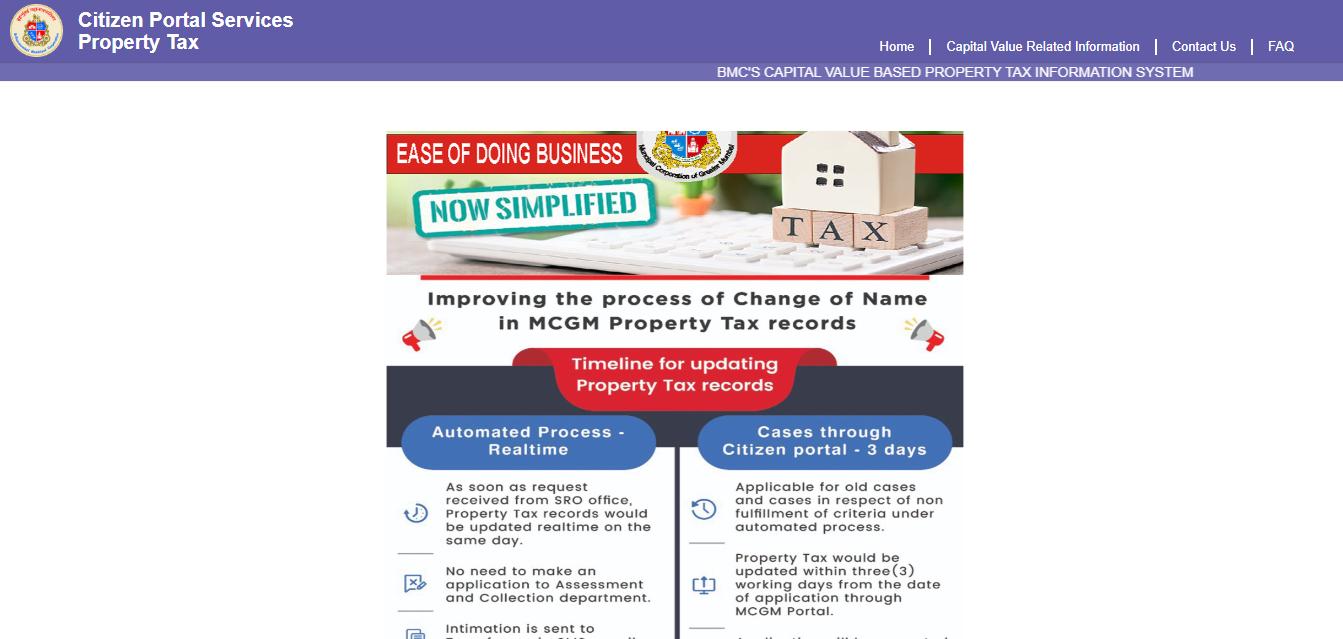 Municipal Corporation of Greater Mumbai Website
Municipal Corporation of Greater Mumbai Website
Navi Mumbai Municipal Corporation (NMMC) Property Tax Collection
In contrast to BMC's Capital Value System, the Navi Mumbai Municipal Corporation (NMMC) collects property tax based on a certain percentage of the property's rateable value. This approach reflects variations in property tax assessment methodologies across different municipal corporations in the Mumbai metropolitan region.
Also Read: Property Tax In Navi Mumbai - 2024
Property Tax in Gurugram
Property tax in Gurugram is determined by considering two primary factors: the area of the property and its use, which can be categorized into residential/non-commercial or commercial. This approach ensures that property owners contribute to the local governance based on the size and purpose of their properties.
The Municipal Corporation of Gurugram (MCG) facilitates easy property tax payments through its online platform, making it convenient for residents to fulfill their tax obligations. By visiting the MCG website and entering either your unique Property ID number or providing your name and address, you can quickly access the amount due for your property tax payment.
MCG Website:
https://www.mcg.gov.in/HouseTax.aspx
 Municipal Corporation of Gurugram Website
Municipal Corporation of Gurugram Website
Factors Influencing Property Tax in Gurugram
Area of Property:
The size of the property, typically measured in square feet or square meters, plays a significant role in determining the property tax amount. Larger properties generally attract higher tax payments due to their increased value and potential usage.
Use of Property:
- Residential/Non-commercial: Properties used solely for residential purposes are categorized differently from commercial or non-residential properties. Tax rates may vary based on this classification.
- Commercial: Properties utilized for commercial activities, such as offices, shops, or industrial establishments, are subject to different tax rates reflecting their commercial value and usage.
Property Tax in Delhi
The Municipal Corporation of Delhi (MCD) implements the 'Unit Area System' for property tax assessment across the city. Let's delve into the details of how property tax is calculated under this system and explore key factors that influence the tax amount.
MCD Website:
https://mcdonline.nic.in/portal
 Municipal Corporation of Delhi Website
Municipal Corporation of Delhi Website
Property Tax Calculation Formula
The formula used by MCD for property tax calculation is as follows:
Property Tax= Annual Value×Rate of Tax
The components of the formula are:
Annual Value: This is determined based on several factors and is calculated using the formula:
Annual Value=Unit Area Value per sq meter×Unit Area of Property×Age Factor×Use Factor×Structure Factor×Occupancy Factor
- Unit Area Value per sq meter: The value assigned to each square meter of property based on its location and other factors.
- Unit Area of Property: The total area of the property in square meters.
- Age Factor: Depreciation factor based on the age of the property.
- Use Factor: Classification of property usage such as residential, commercial, industrial, etc.
- Structure Factor: Property structure type, like a flat, independent house, or commercial building.
- Occupancy Factor: Indicates whether the property is self-occupied or rented out.
- Rate of Tax: The tax rate applied to the annual value, which may vary based on property type, usage, and other factors determined by the MCD.
Factors Influencing Property Tax Calculation
- Location: Different areas within Delhi may have varying unit area values and tax rates based on factors like infrastructure, amenities, and development status.
- Property Characteristics: Age, usage, structure type, and occupancy status significantly impact the annual value and, consequently, the property tax amount.
- Tax Rate Variations: The MCD may apply different tax rates for residential, commercial, and industrial properties, as well as for properties falling under specific categories like vacant land or heritage buildings.
- Tax Exemptions and Rebates: Certain categories of properties or property owners may be eligible for tax exemptions, rebates, or concessions as per MCD regulations.
Property Tax in Hyderabad
The Greater Hyderabad Municipal Corporation (GHMC) utilizes a slab rate system based on the annual rental value to determine property tax rates in Hyderabad. This system is instrumental in ensuring a fair and standardized approach to property tax assessment across residential properties. Let's explore the formula and factors involved in calculating property tax in Hyderabad under the GHMC's guidelines.
GHMC Website:
https://onlinepayments.ghmc.gov.in/
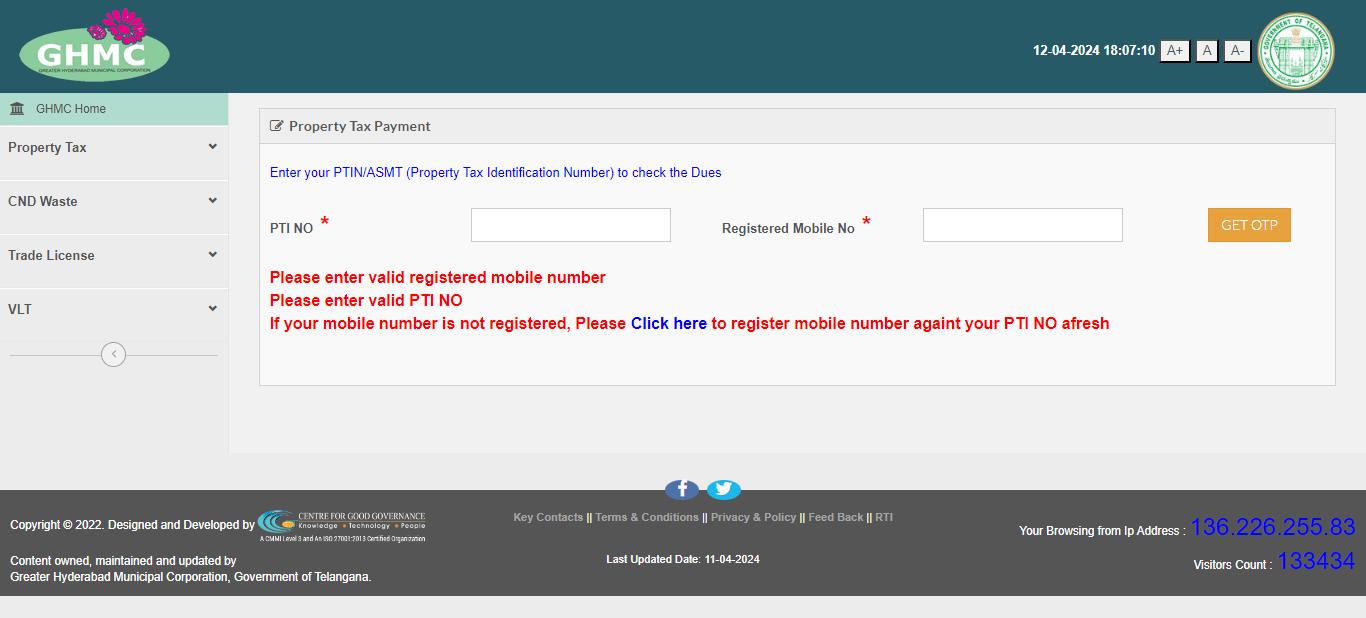 Greater Hyderabad Municipal Corporation Website
Greater Hyderabad Municipal Corporation Website
Property Tax Calculation Formula
The formula used by GHMC for calculating property tax on residential properties is as follows:
Annual Property Tax= Plinth Area×Monthly Rental Value per sq ft×12×(Slab Rate Factor)-10% Depreciation+8% Library Cess
Key components of the formula include:
- Plinth Area: Total built-up area of the property, measured in square feet, which is a key determinant of the property tax amount.
- Monthly Rental Value per sq ft: The rental value assigned to each square foot of the property's area, which varies based on location, amenities, and market trends.
- Slab Rate Factor: GHMC uses a slab rate of taxation based on the annual rental value (MRV) of properties. The factor ranges from 0.17 to 0.30 depending on the MRV and the applicable slab rate.
- Depreciation: A standard depreciation rate of 10% may apply to certain properties based on their age and condition, reducing the taxable amount.
- Library Cess: GHMC may levy an additional 8% library cess on the calculated property tax amount for specific civic development purposes.
Factors Influencing Property Tax Calculation
- Location and MRV: The location of the property within Hyderabad and its annual rental value significantly influence the slab rate factor and, consequently, the property tax amount.
- Plinth Area and Construction Type: Larger properties with more built-up area and different construction types (e.g., apartments, independent houses) may have varying tax liabilities.
- Age and Condition: Older properties may be subject to depreciation, reducing their taxable value. The condition and maintenance of the property also play a role.
- Civic Cess and Charges: Apart from property tax, GHMC may impose additional cess or charges for specific civic amenities and services.
Property Tax in Chennai
GCC Website:
https://chennaicorporation.gov.in/gcc/online-payment/property-tax/
 Greater Chennai Corporation Website
Greater Chennai Corporation Website
The Greater Chennai Corporation (GCC) employs the Reasonable Letting Value (RLV) system to calculate property tax, focusing on various factors that contribute to the annual rental value of a property. Let's delve deeper into the considerations and factors that the GCC takes into account when assessing property tax in Chennai.
Factors Considered in Property Tax Assessment
- Plinth Area: The total built-up area of the property, including all floors, is a crucial factor in determining the property tax. Larger properties with more built-up area generally attract higher tax amounts.
- Basic Rate of the Street: The location of the property on a particular street or area within Chennai is significant. The GCC considers the basic rate of the street or locality as part of the tax assessment process.
- Usage of the Building: The type of usage, whether residential or non-residential (commercial, industrial, etc.), plays a role in determining the tax rate. Different categories of properties may have distinct tax rates.
- Nature of Occupancy: The nature of occupancy refers to whether the property is owner-occupied or rented out to tenants. The GCC may have different tax considerations based on this factor.
- Age of the Building: The age of the building is also taken into consideration. Older buildings may have different tax rates or depreciation factors compared to newer constructions.
Importance of Property Tax Assessment
- Revenue Generation: Property tax serves as a significant revenue source for the Greater Chennai Corporation. It funds various civic amenities, infrastructure development projects, and public services within the city.
- Fairness and Transparency: The RLV system aims to ensure fairness and transparency in property tax assessment by considering relevant factors that reflect the property's value and usage.
- Tax Compliance: Understanding the factors that influence property tax assessment helps property owners comply with tax regulations, estimate their tax liabilities accurately, and make timely tax payments to the GCC.
Property Tax in Kolkata
KMC Website:
https://www.kmcgov.in/KMCPortal/jsp/KMCAssessmentCurrentPD.jsp
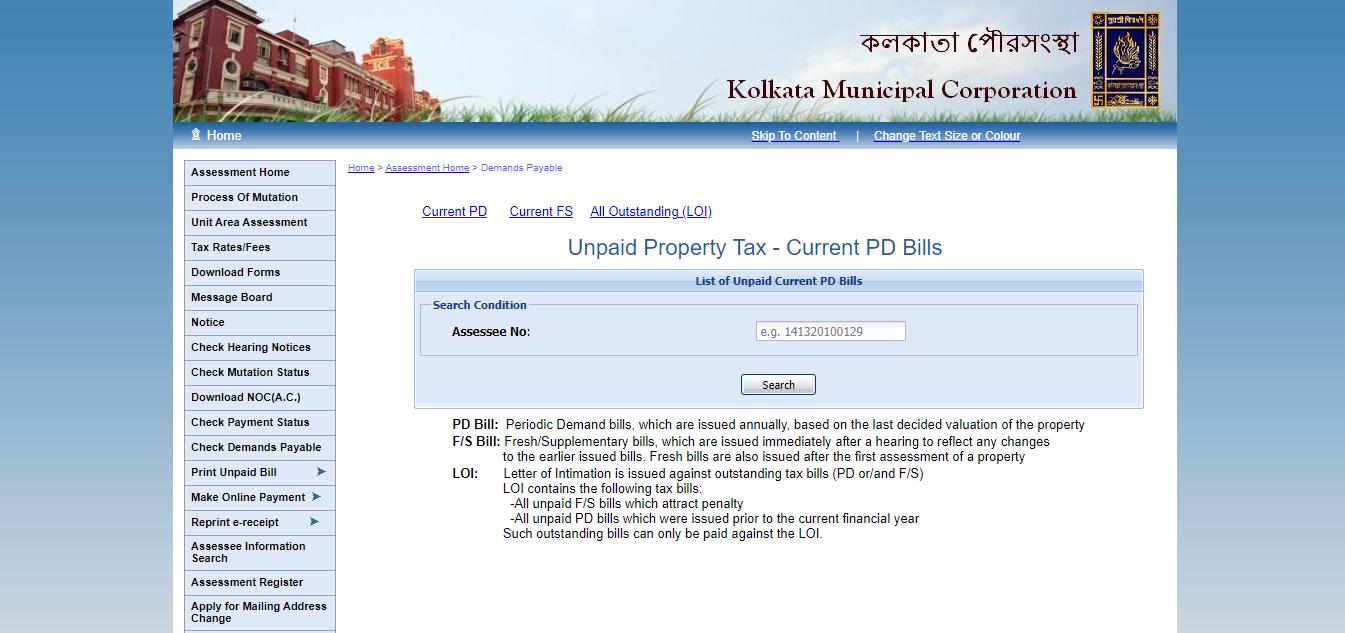 Kolkata Municipal Corporation Website
Kolkata Municipal Corporation Website
The introduction of the Unit Area Assessment (UAA) system in March 2017 marked a significant shift in property tax calculation within the Kolkata Municipal Corporation (KMC). This system, based on multiplicative factors (MFs), brings a more nuanced approach to property tax assessment by considering various critical factors that differentiate houses within the same locality. Let's explore the formula and factors involved in calculating property tax in Kolkata under the UAA system.
Property Tax Calculation Formula
The annual property tax under the UAA system is calculated using the following comprehensive formula:
Annual Tax= Base Unit Area Value×Covered Space/Land Area×Location MF Value×Usage MF Value×Age MF Value×Structure MF Value×Occupancy MF Value×Rate of Tax (including HB Tax)
Let's break down the components of the formula:
- Base Unit Area Value: This is the foundational value assigned to each unit area of the property, often determined by factors like location, amenities, and infrastructure.
- Covered Space/Land Area: The ratio of the covered space (built-up area) to the total land area of the property, which reflects the property's utilization and density.
- Multiplicative Factors (MFs): These factors (Location, Usage, Age, Structure, Occupancy) capture the unique characteristics of each property and adjust the tax calculation accordingly. They account for differences such as property location, purpose (residential/commercial), age of the building, type of structure, and occupancy status.
- Rate of Tax (including HB Tax): The applicable tax rate, which includes any additional taxes or charges such as the Howrah Bridge (HB) tax for properties in specific wards.
Factors Influencing Property Tax Calculation
- Location MF Value: Reflects the locality or area-based factors that influence property values and tax rates.
- Usage MF Value: Differentiates between residential, commercial, industrial, and other property types, each with its tax implications.
- Age MF Value: Accounts for depreciation or age-related adjustments in property value and tax assessment.
- Structure MF Value: Considers the type of construction or building structure, such as apartments, independent houses, or commercial complexes.
- Occupancy MF Value: Differentiates between owner-occupied and rented properties, impacting tax assessments based on property usage.
Property Tax in Ahmedabad
The Amdavad Municipal Corporation (AMC) employs a systematic approach to calculate property tax based on the capital value of properties in Ahmedabad. Let's delve into the formula and the factors involved in the manual calculation of property tax by the AMC.
Property Tax Calculation Formula
The formula used by the AMC for manual calculation of property tax is as follows:
Property Tax=Area×Rate×(f1×f2×f3×f4×fn)
Here are the key components of the formula:
- Area: Refers to the total area of the property, measured in square feet or square meters.
- Rate: Represents the applicable tax rate determined by the Amdavad Municipal Corporation.
- f1,f2,f3,f4,fn: These are weightage factors assigned to various parameters that influence the property tax calculation.
- f1: Weightage given to the location of the property, considering factors like accessibility, infrastructure, and amenities in the area.
- f2: Weightage given to the type of property, distinguishing between residential, commercial, industrial, or other categories.
- f3: Weightage given to the age of the property, which may include depreciation factors or adjustments based on the property's age.
- f4: Weight assigned specifically to residential buildings, reflecting the usage and characteristics of residential properties.
- fn: Weightage assigned based on the user of the property, considering factors like owner-occupancy, tenancy, or commercial use.
Factors Influencing Property Tax Calculation
- Location Weightage (f1): The location of the property within Ahmedabad, including factors like proximity to amenities, transport facilities, and overall development in the area, impacts the tax calculation.
- Type of Property (f2): Different property types have varying tax implications. Residential, commercial, and industrial properties may have distinct tax rates or weightage factors.
- Age of Property (f3): Older properties may have different tax considerations due to depreciation or adjustments based on their age and condition.
- Residential Building Weightage (f4): Weight assigned specifically to residential buildings accounts for their usage patterns and characteristics compared to commercial or industrial properties.
- User of Property (fn): The user of the property, such as owner-occupancy or tenancy, influences the tax calculation and weightage factors applied.
Property Tax in Chandigarh
Property tax in Chandigarh is calculated based on specific criteria and exemptions, making it important for residents to understand the nuances of the tax system and payment methods available.
Property Tax Calculation for Plots
- For plots in Chandigarh, property tax calculation considers only the vacant plot area outside the plinth area of the ground floor. For instance, if a plot has an area of 500 sq yards and the plinth area is 300 sq yards, the taxable vacant plot area will be 200 sq yards. Tax is then calculated based on this vacant plot area.
Exemptions and Special Cases
- Residential Lands and Buildings: Self-occupied residential properties of up to 300 sq yards are exempt from property tax. This exemption benefits individuals such as veterans from the naval, military, or air force, widows, and differently-abled people.
Online Payment Options:
- Residents can conveniently make online property tax payments by searching for property details using their property ID.
- Alternatively, online payments can also be made by searching property details with the house and sector number, providing flexibility to property owners.
Payment at e-Sampark Centers:
- Chandigarh residents have the option to deposit property tax at all e-Sampark Centers located across the city. These centers provide accessible avenues for tax payment and assistance.
Property Tax in Nagpur
In Nagpur, property tax calculation follows the Unit Area System, ensuring a fair and transparent assessment of tax liabilities. The process involves multiplying the property's annual value by the applicable tax rate to determine the property tax amount.
Key Features:
- Unit Area System: This method considers various factors such as the size, location, and type of property to determine the annual value for tax assessment.
- Online Property Tax Calculator: The Nagpur Municipal Corporation (NMC) provides an online property tax calculator, allowing property owners to calculate their tax liabilities conveniently by entering the required property details.
- Real-Time Calculation: Property owners can obtain real-time property tax estimates through the online calculator, ensuring accuracy and transparency in tax assessment.
- Ease of Use: The online calculator simplifies the tax calculation process, eliminating the need for manual calculations and reducing the chances of errors.
Property Tax in Noida
Noida's property tax system is based on a certain percentage of the annual assessed value of the property, with tax rates varying based on the property's location and other factors. The Noida Authority oversees the assessment and collection of property taxes in the region.
Key Highlights:
- Percentage of Assessed Value: Property taxes in Noida are determined as a percentage of the annual assessed value of the property, ensuring that tax liabilities align with the property's value and usage.
- Location-Based Taxation: The Noida Authority considers the property's location, infrastructure, amenities, and development status when determining tax rates, ensuring equitable taxation across different areas of the city.
Property Tax in Kochi
In Kochi, property tax calculation is primarily based on the plinth area of the property, with different tax rates applicable to areas under panchayats, municipalities, and corporations. The tax assessment aims to generate revenue for local governance and development initiatives.
Key Features:
- Plinth Area Assessment: Property tax calculation in Kochi revolves around the plinth area of the property, reflecting the size and construction details of the building.
- Differentiated Charges: Tax rates may vary for properties located in panchayath, municipality, and corporation areas, considering factors such as infrastructure development, amenities, and services provided by local authorities.
- Revenue Generation: Property tax revenues contribute to funding essential services, infrastructure development, and maintenance projects undertaken by local governing bodies, ensuring the well-being and progress of the city.
Understanding House Property Income Taxation
|
Aspect |
Calculation/Consideration |
|
Taxation Basis |
Taxation is based on the Net Annual Value (NAV) of the house property. |
|
Net Annual Value (NAV) Calculation |
NAV = Gross Annual Value - Municipal Taxes |
|
Gross Annual Value (GAV) |
GAV = Total Rent Received |
|
Example of NAV Calculation |
If you receive Rs. 1.2 lakh in rent per year and pay Rs. 40,000 in municipal taxes, the NAV is Rs. 80,000. |
|
Handling Vacancy Periods |
During unoccupied periods, consider only the rent received, not the total amount. |
|
Example of Handling Vacancy |
If a house rented for Rs. 17,000/month for four months of the fiscal year is vacant, its GAV will be Rs. 1,36,000 (Rs. 17,000 * 8 months). |
|
Standard Deduction |
Deduct 30% as a standard deduction from the GAV before calculating taxable income. |
|
Offset Vacancy Loss Against Other Income |
If a property is vacant but municipal taxes are paid, offset this loss against income from other sources during the same fiscal year. |
|
Carry Forward Losses |
If the loss cannot be offset in the same year, it can be carried forward for up to eight years. |
|
Example of Tax Calculation with Vacancy and Deductions |
Using the above example, after deducting municipal taxes and the standard deduction, the taxable income would be calculated for tax purposes. |
|
Utilization of Vacancy Loss for Taxation Planning |
Vacancy losses can be used strategically to reduce overall taxable income and may require planning for optimal tax benefits. |
This table breaks down the aspects of house property income calculation, including taxation basis, NAV calculation, handling vacancy periods, deductions, offsetting losses, and tax planning considerations.
What is a Tax Application Number?
Understanding your tax application number is crucial when handling property tax payments online. Follow these steps to access your new application number through your municipality's property tax portal:
Step 1: Visit your municipality's property tax webpage.
Step 2: Look for the option labeled "GIS-based New PID" and select it.
Step 3: At the bottom of the page, find the link that says "To Know Your New PID Click Here" and click on it.
Step 4: Enter your old application number in the provided field and then click the "search" button.
Step 5: Once the system retrieves your information, select a name associated with the property and click on "Fetch."
Step 6: Review the displayed information for any discrepancies or errors in the details provided.
Step 7: For additional insights, click on "View your property in Map" to access more property-related data.
Step 8: Use Google Maps to pinpoint and locate your property accurately.
Step 9: You can download or save the details for future reference or record-keeping purposes.
By following these steps, you can easily access and verify your tax application number online, ensuring smooth and accurate property tax transactions.
How to download Property Tax Receipts?
Steps to download a property tax receipt or challan online after making the tax payment:
Step 1: Go to the official website of your relevant Municipal Corporation.
Step 2: Log in to your citizen account using OTP (One-Time Password) for authentication.
Step 3: Once logged in, you will see the details of your property tax payment displayed on the screen.
Step 4: Choose the 'Action' option and navigate to 'tax paid details.'
Step 5: Look for the 'download receipt' option and click on 'download' to complete the process.
Following these steps will enable you to easily download your property tax receipt or challan online, providing you with a digital record of your tax payment.
Why is Paying Property Tax Important?
Paying property tax holds significant importance for property owners due to several reasons:
1. Legal Compliance:
Property tax is a mandatory obligation for property owners as per municipal regulations. Complying with this tax requirement ensures that you are fulfilling your legal responsibilities as a property owner.
2. Proof of Ownership:
Property tax receipts serve as vital documents to establish proof of ownership during property disputes or legal matters. These receipts verify your status as the rightful owner of the property and can be crucial evidence in case of any disputes.
3. Property Title Updates:
Clearing property tax dues and updating your name in municipal records is essential when buying or selling property. Without clearing outstanding tax arrears, transferring property titles or updating ownership details can be delayed or restricted.
4. Loan Eligibility:
Property tax payment records are often required when applying for loans, such as loans against property (LAP) or mortgages. Lenders may request property tax receipts to verify property ownership and assess the property's financial standing.
5. Documentation for Municipal Records:
To update property records with the municipal authorities, you may need to submit various documents, including the sale deed, address proof, photo identification, and proof of tax payment. Keeping your property tax payments up-to-date ensures smoother administrative processes.
6. Exemptions and Incentives:
While property tax is generally mandatory, certain properties such as government buildings, places of worship, and clean land may be exempt from tax obligations. Municipalities may also offer incentives or discounts for timely online property tax payments, encouraging compliance and convenience for property owners.
7. Online Payment Convenience:
Many municipal corporations facilitate online property tax payments, providing a convenient and efficient way for property owners to fulfill their tax obligations. Online payments are often incentivized and help streamline the tax collection process for authorities.
Paying property tax on time not only fulfills legal requirements but also safeguards your ownership rights, aids in property transactions, and supports financial activities related to your property. Keeping tax payments up-to-date and maintaining accurate records with municipal bodies is essential for smooth property management and compliance with regulatory norms.
Penalties for Non Payment
Authorities enforce penalties for non-payment of property tax to ensure timely tax compliance. The penalties vary across cities, typically ranging from 1% to 2% of the outstanding amount per month. For instance, the Brihanmumbai Municipal Corporation imposes a 1% monthly penalty on overdue property tax, while Bangalore enforces a 2% penalty.
Persistent delays in payment can lead to more severe consequences, such as property attachment and auctioning by authorities to recover outstanding dues. For example, the Navi Mumbai Municipal Corporation (NMMC) has published lists of properties subject to attachment in cases of non-payment of property tax.
These penalties serve as deterrents for property owners to fulfill their tax obligations promptly and contribute to local governance and development initiatives.
Conclusion
To conclude, navigating the realm of Property Tax in India as of 2025 involves understanding diverse calculation methods, exemptions for specific groups, potential penalties for non-compliance, and the convenience of online payment platforms. This knowledge equips property owners nationwide to effectively manage their tax responsibilities, contributing to local governance and infrastructure while ensuring compliance with tax regulations.
explore further
Latest from Editorials
More from Publications
Resources
Dwello, for every home buyer, is a way to go from 'I feel' to 'I know', at no extra cost.




